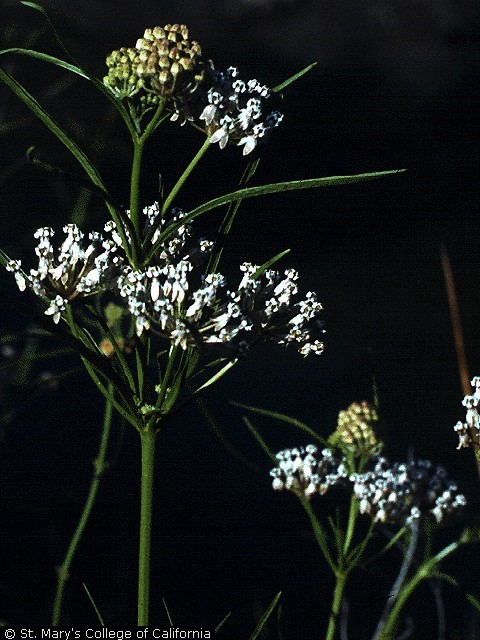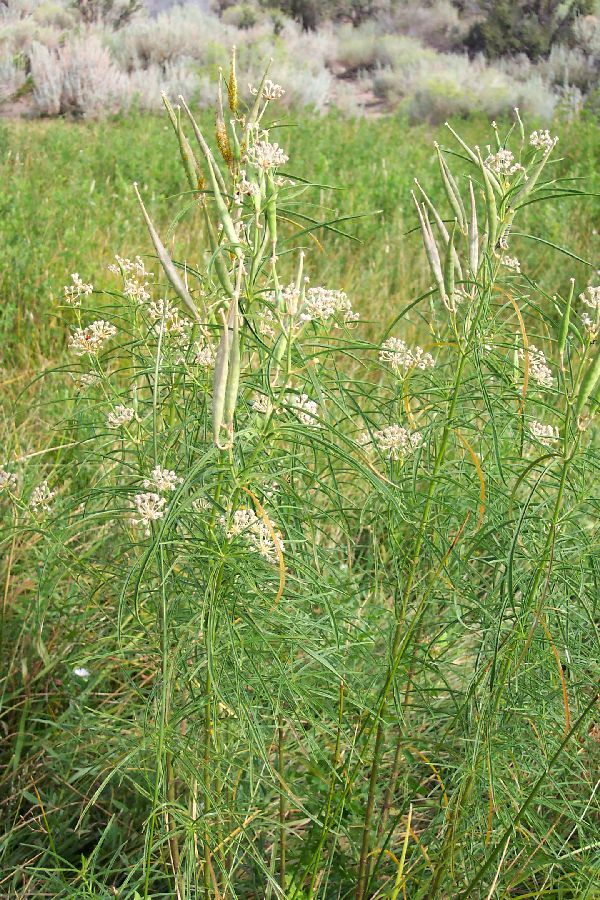 |
|
Brother Alfred Brousseau @ USDA-NRCS PLANTS Database |
 |
| USDA-NRCS PLANTS Database |
Translate this page:
Summary
Physical Characteristics

 Asclepias mexicana is a PERENNIAL growing to 0.8 m (2ft 7in).
Asclepias mexicana is a PERENNIAL growing to 0.8 m (2ft 7in).
See above for USDA hardiness. It is hardy to UK zone 6. The species is hermaphrodite (has both male and female organs) and is pollinated by Bees, insects, Lepidoptera (Moths & Butterflies).
Suitable for: light (sandy) soils and prefers well-drained soil. Suitable pH: mildly acid, neutral and basic (mildly alkaline) soils. It can grow in semi-shade (light woodland) or no shade. It prefers dry or moist soil.
UK Hardiness Map
US Hardiness Map
Synonyms
A. mexicana. Rydb. non Cav. = A. fascicularis. Decne.
Plant Habitats
Cultivated Beds;
Edible Uses
Edible Parts: Flowers
Edible Uses:
Young blossoms - cooked[161, 177]. Some caution is advised, see the notes on toxicity at the top of the page.
References More on Edible Uses
Medicinal Uses
Plants For A Future can not take any responsibility for any adverse effects from the use of plants. Always seek advice from a professional before using a plant medicinally.
None known
References More on Medicinal Uses
The Bookshop: Edible Plant Books
Our Latest books on Perennial Plants For Food Forests and Permaculture Gardens in paperback or digital formats.

Edible Tropical Plants
Food Forest Plants for Hotter Conditions: 250+ Plants For Tropical Food Forests & Permaculture Gardens.
More

Edible Temperate Plants
Plants for Your Food Forest: 500 Plants for Temperate Food Forests & Permaculture Gardens.
More

More Books
PFAF have eight books available in paperback and digital formats. Browse the shop for more information.
Shop Now
Other Uses
Latex
Rubber can be made from latex contained in the leaves and the stems[112].
Special Uses
References More on Other Uses
Cultivation details
Prefers a well-drained light rich or peaty soil in a sunny position[1, 200]. Succeeds in poor soils. There is some confusion over nomenclature. A. mexicana. Rydb. is a synonym of A. fascicularis and the reports on the uses of this plant did not specify the authors name[60]. We have assumed that the uses refer to A. mexicana. Cav. There is also some confusion over the hardiness of this plant with one report saying that it needs greenhouse protection in Britain[1] whilst another says that it is hardy to zone 6, or about -20°c[200]. Many members of this genus seem to be particularly prone to damage by slugs. The young growth in spring is especially vulnerable, but older growth is also attacked and even well-established plants have been destroyed in wet years[K]. Plants resent root disturbance and are best planted into their final positions whilst small[134]. The flower of many members of this genus can trap insects between its anther cells, the struggles of the insect in escaping ensure the pollination of the plant[207].
References Carbon Farming Information and Carbon Sequestration Information
Temperature Converter
Type a value in the Celsius field to convert the value to Fahrenheit:
Fahrenheit:
The PFAF Bookshop
Plants For A Future have a number of books available in paperback and digital form. Book titles include Edible Plants, Edible Perennials, Edible Trees,Edible Shrubs, Woodland Gardening, and Temperate Food Forest Plants. Our new book is Food Forest Plants For Hotter Conditions (Tropical and Sub-Tropical).
Shop Now
Plant Propagation
Seed - best sown in a greenhouse as soon as it is ripe in the autumn or in late winter[134, 169]. We have also had good results from sowing the seed in the greenhouse in early spring[K], though stored seed might need 2 - 3 weeks cold stratification[134]. Germination usually takes place in 1 - 3 months at 18°c[134]. As soon as the seedlings are large enough to handle, prick them out into individual pots and grow them on in the greenhouse for their first winter. Plant out when they are in active growth in late spring or early summer and give them some protection from slugs until they are growing away strongly. Division in spring. With great care since the plant resents root disturbance. Pot the divisions up and place them in a lightly shaded position in the greenhouse until they are growing away strongly, then plant them out in the summer, giving them some protection from slugs until they are established.. Basal cuttings in late spring. Use shoots about 10cm long with as much of their white underground stem as possible. Pot them up individually and place them in a lightly shaded position in a greenhouse until they are rooting and growing actively. If the plants grow sufficiently, they can be put into their permanent positions in the summer, otherwise keep them in the greenhouse until the following spring and when they are in active growth plant them out into their permanent positions. Give them some protection from slugs until they are established.
Other Names
If available other names are mentioned here
Native Range
NORTHERN AMERICA: Mexico (Chihuahua, Nuevo León, San Luis Potosí, Tamaulipas, Guanajuato, México, Michoacán de Ocampo, Oaxaca, Veracruz de Ignacio de la Llave, Ciudad de México)
Weed Potential
Right plant wrong place. We are currently updating this section.
Please note that a plant may be invasive in one area but may not in your area so it's worth checking.
Conservation Status
IUCN Red List of Threatened Plants Status :

| Related Plants
|
| Latin Name | Common Name | Habit | Height | Hardiness | Growth | Soil | Shade | Moisture | Edible | Medicinal | Other |
| Asclepias asperula | Spider milkweed | Perennial | 0.6 |
5-9
| M | LM | SN | DM | 4 | 1 | 3 |
| Asclepias brachystephana | Bract milkweed | Perennial | 0.3 |
0-0
| | L | SN | DM | 0 | 0 | 2 |
| Asclepias californica | California Milkweed, Greene's milkweed | Perennial | 0.5 |
0-0
| | L | SN | DM | 2 | 1 | 2 |
| Asclepias currasavica | Blood Flower | Perennial | 2.0 |
10-12
| F | LMH | N | M | 0 | 1 | 2 |
| Asclepias decumbens | | Perennial | 0.9 |
-
| | L | SN | DM | 2 | 0 | 2 |
| Asclepias eriocarpa | Woollypod Milkweed | Perennial | 0.9 |
6-10
| | L | SN | DM | 2 | 2 | 3 |
| Asclepias erosa | Desert Milkweed | Perennial | 0.8 |
0-0
| | L | N | DM | 3 | 0 | 3 |
| Asclepias fascicularis | Mexican milkweed | Perennial | 0.8 |
7-10
| F | LM | N | DM | 1 | 0 | 1 |
| Asclepias galioides | Bedstraw Milkweed | Perennial | 0.4 |
-
| | L | SN | DM | 2 | 1 | 2 |
| Asclepias hallii | Purple Silkweed, Hall's milkweed | Perennial | 1.0 |
3-7
| | LM | SN | DM | 3 | 1 | 3 |
| Asclepias incarnata | Swamp Milkweed, Swamp Butterfly Weed, Marsh Milkweed | Perennial | 1.2 |
3-8
| M | LM | SN | DMWe | 3 | 2 | 3 |
| Asclepias involucrata | Dwarf Milkweed | Perennial | 0.0 |
-
| | L | SN | DM | 2 | 1 | 2 |
| Asclepias lanceolata | Purple Silkweed, Fewflower milkweed | Perennial | 1.2 |
4-8
| | LM | SN | DM | 2 | 1 | 3 |
| Asclepias latifolia | Broadleaf Milkweed | Perennial | 0.8 |
-
| | L | SN | DM | 0 | 1 | 2 |
| Asclepias ovalifolia | Oval-leaf milkweed | Perennial | 0.6 |
5-9
| | LM | SN | DM | 2 | 0 | 3 |
| Asclepias pumila | Low Milkweed, Plains milkweed | Perennial | 0.4 |
5-9
| | LM | SN | DM | 2 | 1 | 3 |
| Asclepias purpurascens | Purple Milkweed | Perennial | 0.8 |
-
| | LM | SN | DM | 2 | 1 | 3 |
| Asclepias quadrifolia | Fourleaf Milkweed | Perennial | 0.5 |
4-8
| | LM | SN | DM | 2 | 2 | 3 |
| Asclepias rubra | Red Silkweed | Perennial | 1.2 |
4-8
| | LM | SN | DM | 3 | 1 | 3 |
| Asclepias speciosa | Showy Milkweed | Perennial | 0.8 |
3-9
| | LM | SN | DM | 4 | 2 | 3 |
| Asclepias subulata | Rush Milkweed | Perennial | 2.0 |
5-9
| | L | SN | DM | 0 | 1 | 3 |
| Asclepias subverticillata | Poison Milkweed | Perennial | 0.4 |
6-10
| F | LM | N | DM | 1 | 0 | 0 |
| Asclepias sullivantii | Prairie milkweed | Perennial | 1.2 |
0-0
| | L | SN | DM | 0 | 0 | 3 |
| Asclepias syriaca | Common Milkweed, Silkweed, Milkweed | Perennial | 1.0 |
3-8
| M | LM | SN | DM | 3 | 2 | 3 |
| Asclepias tuberosa | Pleurisy Root, Butterfly milkweed, Rolfs' milkweed, Indian Paintbrush | Perennial | 0.8 |
3-9
| M | LM | SN | DM | 3 | 3 | 4 |
| Asclepias viridiflora | Green Milkweed, Green comet milkweed | Perennial | 1.0 |
0-0
| | LM | SN | DM | 3 | 2 | 3 |
|
Growth: S = slow M = medium F = fast. Soil: L = light (sandy) M = medium H = heavy (clay). pH: A = acid N = neutral B = basic (alkaline). Shade: F = full shade S = semi-shade N = no shade. Moisture: D = dry M = Moist We = wet Wa = water.
Now available:
Food Forest Plants for Mediterranean Conditions
350+ Perennial Plants For Mediterranean and Drier Food Forests and Permaculture Gardens.
[Paperback and eBook]
This is the third in Plants For A Future's series of plant guides for food forests tailored to
specific climate zones. Following volumes on temperate and tropical ecosystems, this book focuses
on species suited to Mediterranean conditions—regions with hot, dry summers and cool, wet winters,
often facing the added challenge of climate change.
Read More
Expert comment
Author
Cav.
Botanical References
Links / References
For a list of references used on this page please go here
Readers comment
| Add a comment |
|
If you have important information about this plant that may help other users please add a comment or link below. Only comments or links that are felt to be directly relevant to a plant will be included. If you think a comment/link or information contained on this page is inaccurate or misleading we would welcome your feedback at [email protected]. If you have questions about a plant please use the Forum on this website as we do not have the resources to answer questions ourselves.
* Please note: the comments by website users are not necessarily those held by PFAF and may give misleading or inaccurate information.
To leave a comment please Register or login here All comments need to be approved so will not appear immediately.
|
Subject : Asclepias mexicana
|
|
|
|